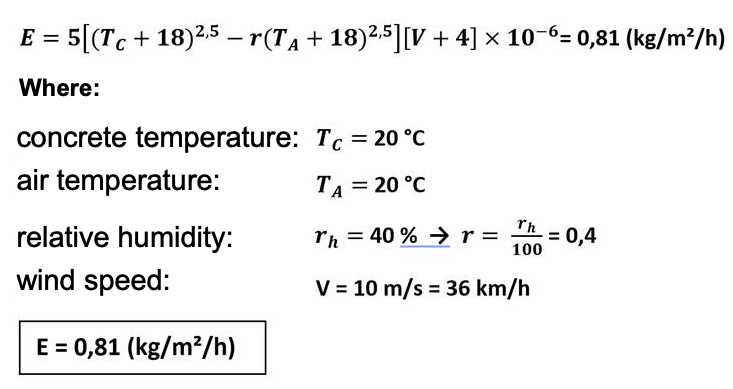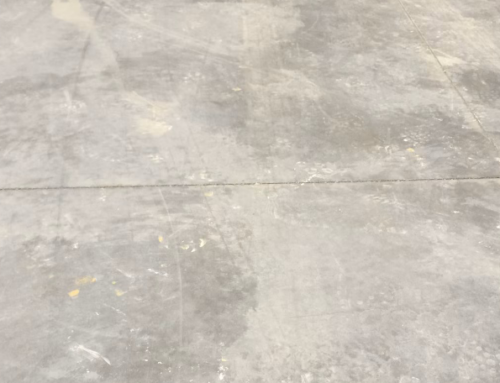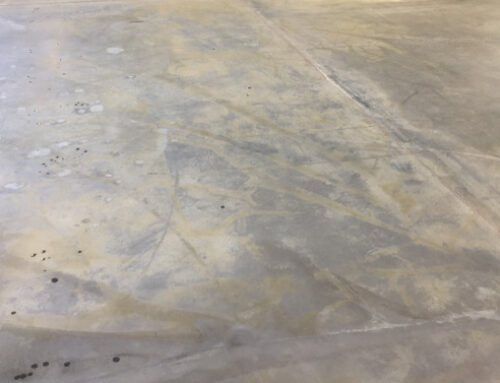The increasingly summer-like weather is causing more and more problems with cracking of concrete surfaces. In windy and hot weather, water evaporates very intensively from the concrete surface and the risk of plastic shrinkage cracking is very high. Thus, post-casting maintenance becomes very important in higher air temperatures. The hydration process of concrete is most intense in the initial stage and it is necessary to ensure favorable curing conditions at that time. In summer conditions, these conditions mainly mean preventing excessive water evaporation from the surface. Without water, the curing process slows down or stops altogether.
The main visible problem, as mentioned above, is cracking caused by plastic shrinkage. This is mainly caused by too fast drying of the water. Shrinkage causes tensile stresses in the surface layer and if the concrete has not reached sufficient tensile strength to resist these stresses, the surface of the concrete cracks.
The rate of water evaporation depends on the ambient temperature, relative humidity, wind speed, and the temperature of the concrete being installed. The amount of water evaporation can be found using graphs or calculations.
 Example. Amount of water evaporation from the floor surface:
Example. Amount of water evaporation from the floor surface:
The results can be evaluated as follows:
E ≥ 1 – very high risk of plastic shrinkage cracking.
0,5 ≤ E <1 – medium risk of plastic shrinkage cracking.
E < 0,5 – low risk of plastic shrinkage cracking.
To keep moisture on the concrete surface longer, post-casting maintenance is necessary. There are mainly 2 options for this:
- wetting the surface and covering it with a material that prevents evaporation, such as plastic. It is important that the concrete is constantly wet. Alternating between dry and wet rather damages the strength of the concrete surface. Min. maintenance duration is 7 nights.
- covering as soon as possible with a special post-maintenance agent that creates a membrane.
In this case, I focus on post-maintenance agents, as this method is most widespread. As mentioned, the main task of post-maintenance agents is to prevent excessive water evaporation from the concrete surface. These agents are mainly applied with a spray, as soon as possible after the surface finishing of the concrete. If it is a very hot and/or windy weather, then intermediate maintenance should be performed, where the post-maintenance agent is also sprayed after the installation and laying of the concrete, but before the final finishing. This prevents the formation of a dry crust on the surface, which is practically impossible to finish. The BETOTEX product from Betotrade OÜ is suitable for intermediate maintenance. After intermediate maintenance, the concrete surface can be finished in the usual way and the final post-maintenance agent can then be applied.
The most suitable for post-completion maintenance is KOROTEX.
 Maintenance substances should be applied to the surface as evenly as possible. The goal is to achieve an even membrane layer. On smoothly polished surfaces, an even layer will form more easily than on “brush surfaces” or “dish surfaces”. For uneven finishes, the maintenance substance should be increased to ensure proper coverage of the surface. The best means for this is KOROTEX.
Maintenance substances should be applied to the surface as evenly as possible. The goal is to achieve an even membrane layer. On smoothly polished surfaces, an even layer will form more easily than on “brush surfaces” or “dish surfaces”. For uneven finishes, the maintenance substance should be increased to ensure proper coverage of the surface. The best means for this is KOROTEX.
Maintenance substances do not prevent evaporation 100%, which is not a negative feature. Slow moisture release allows concrete to settle and reduces the formation of moisture gradients between the deep and surface layers of concrete.
Properly carried out maintenance can prevent cracking of the concrete surface, curling of plate edges, and ensure the strength properties of the concrete surface. This is the most cost-effective way to avoid costly activities caused by insufficient or completely lacking maintenance.
Products:





